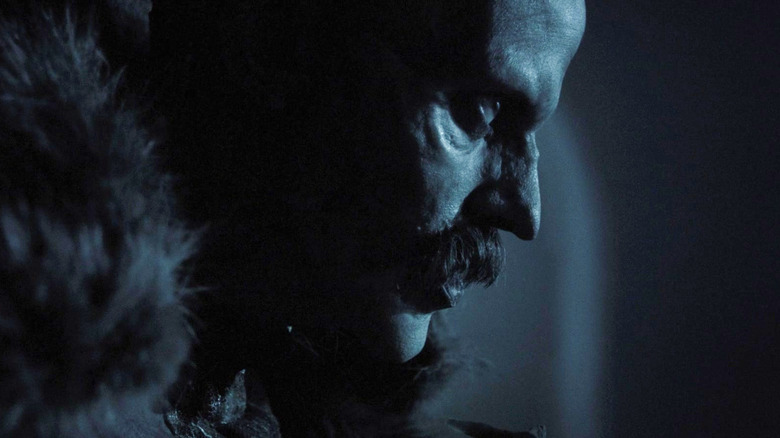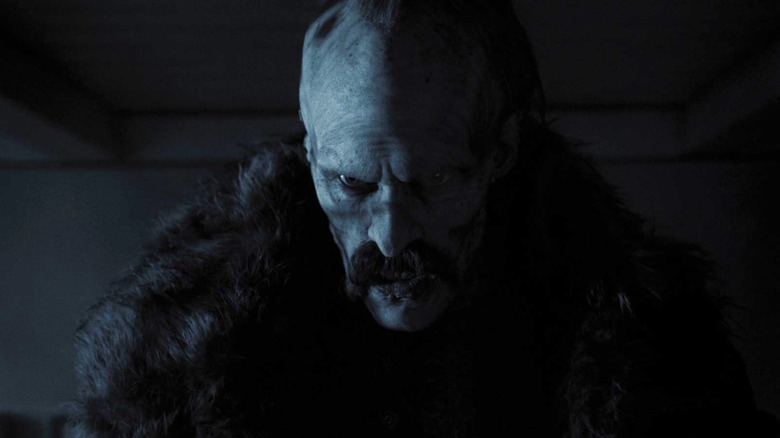Nosferatu Director Responds To Backlash Over Count Orlok's Mustache
Everyone say thank you to Robert Eggers for making Christmas at the movies that much more fun for the weirdos. The filmmaker behind "The Lighthouse" and "The Northman" cast a shadow over the 2024 holiday slate with his chilly re-imagining of the classic F.W. Murnau vampire film "Nosferatu," itself an illegal adaptation of Bram Stoker's "Dracula" novel. It was a massive hit with audiences and critics alike, pulling in an incredible box office haul to sweeten the forbidden deal. Indeed one of the reasons why there was so much intrigue around the film was the mystery behind its central villain.
The lanky bloodsucker known as Count Orlok had previously been played by Max Schreck in 1922 ("Nosferatu: A Symphony of Horror"), Klaus Kinski – albeit as Count Dracula — in 1979 ("Nosferatu the Vampyre"), and Willem Dafoe in 2000 ("Shadow of the Vampire"). Each performance brought something new to the table, but a commonality between them all was presenting the vampire as a towering figure with claw-like fingernails and a nearly bald head. However, the marketing for Eggers' "Nosferatu" wisely prevented people from seeing what Bill Skarsgård's Count Orlok would look like in full before going to see the movie for themselves ... and boy were they in for a surprise.
When Skarsgård's Count came into full view for the first time, audiences were stunned to see that he had a big mustache that covered a good stretch of his face. There was a positive response to this element, but at the same time, there were also a swath of viewers who had an adverse reaction. In an interview with Empire, Eggers responds to the backlash by making it pretty clear that it doesn't really bother him because his Count Orlok was always going to look this way:
"I get that; It's a hard pill for some people to swallow; But I also don't care, because there's just no f—ing way that this guy wouldn't have a mustache; I love the way Max Schreck looks too [in Murnau's original], and it's a change. So, fair play, as people say over here."
The mustache distinguishes Skarsgård's Orlok from other incarnations
Eggers' "Nosferatu" is a strong example of a filmmaker making creative choices that serve their vision rather than catering to audience expectations. I never could have imagined a bushy mustache on Orlok's kisser, but I was pleasantly surprised by the change. It's a sneaky effect on Eggers' part; the first time you get a good glimpse of it, barring that one second jump scare at the top of the film, is when Thomas Hutter (Nicholas Hoult) is dining with Orlok at his Transylvania castle. The secluded vampire is backlit by the fireplace, so you can only make out certain details at first. I recall thinking, "Oh my god, does he actually have a mustache?" It helped me view the film in an entirely new light while I was watching it.
It's safe to assume some audiences weren't happy with the changes that didn't align with the image they had built up in their head. It makes sense, however, for the new kind of screen vampire Eggers was going for in "Nosferatu." Rather than emulating the rat-like visage of Orloks past, Skarsgård's menace of the night is more akin to a walking corpse that has prevailed as the physical manifestation of a plague (be it the disease he spreads throughout Wisborg or the psychosexual stranglehold he has over Lily-Rose Depp's Ellen Hutter).
The look of Skarsgård's Count Orlok is a welcome subversion. Eggers largely envisions the gothic aesthetic of "Nosferatu" as a tribute to Murnau's film, yet he still imbues it with its own identity. The fact there's even anything growing on that face is off-putting in the best way, as if the Count is donning a disguise to make him appear more human than he actually is.
The Extended Cut of "Nosferatu" is currently streaming on Peacock.

